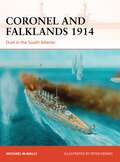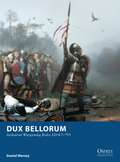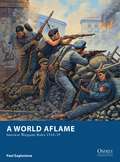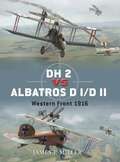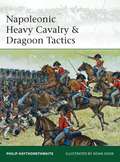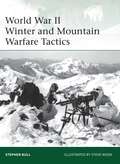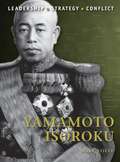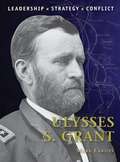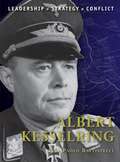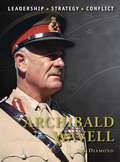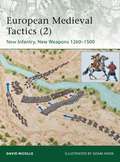- Table View
- List View
Coronel and Falklands 1914: Duel in the South Atlantic (Campaign)
by Peter Dennis Michael McNallyUpon the outbreak of war, the British Royal Navy was deployed globally, whilst the Imperial German Navy was concentrated in two areas – Home Waters and Tsingtao, the home port of the crack East Asia Cruiser Squadron which, under the command of Admiral von Spee contained some of Germany's most modern cruisers. As Spee made his way to the Chilean port of Valparaiso, he met the British 4th Cruiser Squadron which had been ordered to engage and defeat the German force. This resulted in the battle of Coronel where the antiquated British warships proved no match for Spee's modern cruisers. It was the first naval defeat suffered by the Royal Navy in over 100 years. When news reached London, panic reigned and two ships HMS Inflexible and Invincible were sent to lead the force against Spee. When bad weather delayed the German arrival, Spee knew that he had to stand and fight, unaware that amongst the ships opposing him were two modern battlecruisers which outclassed any of his own squadron's ships. Given the presence of Inflexible and Invincible, the result of the battle had an inevitable outcome and after several hours hard combat, Spee's ships were defeated.
Wabash 1791: St Clair’s defeat (Campaign)
by Peter Dennis John F. WinklerThe battle of Wabash, or St. Clair's Massacre, was the greatest defeat of the American Army by Native American forces. The campaign opened in 1791, when an newly formed American Army, under the command of Revolutionary War hero, Arthur St. Clair, set off into the wilderness of Ohio in an effort to wrest control of the Northwest Territory from the various native tribes. Plagued by logistical problems, bad weather, and native ambushes, the expedition dragged on for months as the American army slowly eroded due to injury, sickness, and desertion. Then, on a cold November day, an allied Native army descended on the Americans. In the ensuing chaos, the Americans were slaughtered, taking over 90% casualties. In this book, author John F. Winkler, re-examines this one-sided victory, analyzing what the American's did wrong and how the Natives achieved a victory that they could never repeat.
Napoleon’s Swiss Troops (Men-at-Arms)
by Gerry Embleton David GreentreeEver since the 15th century Switzerland had been exporting professional soldiers to serve as mercenaries for foreign monarchies. Napoleon, therefore, was not the first to make full use of the martial qualities of the Swiss and obtained Swiss agreement to expand the recruitment of regiments for service in the French Army. Napoleon would use Swiss troops on the battlefields of Italy and Spain, and in 1812 re-organize the four original regiments into a single division for the invasion of Russia, with each regiment having three full-strength battalions. In November of 1812, meeting up with Napoleon's main force retreating from Moscow at the Berezina River, the Swiss on the west bank guarded the approaches to the pontoon bridges from the Russian attack to the south. Just 1,200 Swiss out of the approximately 8,000 that entered Russia were left to face, along with 8,000 other remnants of other units, the 30,000-strong Russian army. The Swiss held their ground and when their ammunition ran out they charged the Russians with bayonets. This book reveals the proud combat history of the Swiss troops of Napoleon's army as well as the colourful uniforms they wore.
Dux Bellorum: Arthurian Wargaming Rules AD367–793 (Osprey Wargames)
by Daniel Mersey José Daniel PeñaThe Dark Age of Britain, from the middle of the 4th century to the end of the 8th, was a time of violence and warfare, when charismatic warlords such as the fabled King Arthur could gather together armies and carve out their own kingdoms. With this new set of wargames rules, players can take on the role of these warlords and command their own armies on the tabletop. Written by the author of the popular Glutter of Ravens rules set, Dux Bellorum is an element-based system, where each base of figures represents 50 fighting men. Each player has a specific number of points with which to construct his force and can choose a Late Roman, Romano-British, Welsh, Saxon, Pictish, Irish, or Sea Raider army, amongst others. The game is then played out following a set of simple, fast-paced rules. A completely self-contained gaming system, Dux Bellorum is perfect for gamers who are looking for a way into fighting Dark Age battles without investing a lot of time or money in larger rulesets.
A World Aflame: Interwar Wargame Rules 1918–39 (Osprey Wargames)
by Paul Eaglestone Mark StaceyOften called the †?Pulp Era†?, the years between the two World Wars have seen a tremendous surge in interest among wargamers. A World Aflame captures the adventurous nature of the time period to present a fun, fast-paced set of tabletop miniatures rules that can handle the many diverse conflicts of the period, from the Chinese Civil Wars and the "Great Game†? in Central Asia, to the Irish War of Independence and the bitter ideological warfare of the Russian and Spanish Civil Wars. The rules also contain options for the "Very British Civil War†?. This gaming trend has sprung up in recent years, following a "what-if†? scenario that has Edward VIII refusing to abdicate the throne, thrusting the country into civil war in 1938. It is a quirky, fun setting, and one that is surprisingly popular. Written by a life-long wargamer, A World Aflame focuses on the daring and heroism of battles fought in the last great era of adventure.
British Heavy Cruisers 1939–45 (New Vanguard)
by Paul Wright Angus KonstamThe idea of a heavy cruiser emerged in the aftermath of World War I, and was closely linked to the limits set by the inter-war Washington Naval Treaty. The pre-World War I concept of armoured cruisers had been abandoned, but in their stead the Admiralty saw a place for powerful cruisers, able to patrol the sea lanes of the British Empire, and which were well-armed enough that they could destroy enemy commerce cruisers. The result was a group of British warships, known as the 'Washington Treaty Cruisers', that did everything the Admiralty wanted, but which conformed to the limits imposed by the treaty. These impressive cruisers were high-sided, spacious and stately – perfect peacetime ambassadors for British power. In war they also packed a considerable punch. During World War II the Royal Navy's thirteen heavy cruisers saw service in every theatre of the war, whether facing the Bismarck in the North Atlantic or enduring kamikaze attacks in the Pacific.
British Light Cruisers 1939–45 (New Vanguard)
by Paul Wright Angus KonstamThe light cruiser was a natural development of the sailing frigate – a fast multi-purpose warship that could patrol the sea lanes, protect convoys and scout for enemy battle fleets. By the inter-war period the need for this type of ship was even more important, given the increasing need for protection from aircraft, and the need to screen the fleet from submarines or destroyers. Wartime experience had shown that the British light cruiser was one of the most versatile types of ship in the Royal Navy, able to protect other warships, bombard enemy shores, guard life-saving convoys and intercept and destroy enemy warships. These were truly the workhorses of the wartime Royal Navy. While the battleships and carriers grabbed the headlines, these sleek, elegant warships quietly got on with the job of securing control of the seas.
Austro-Hungarian Battleships 1914–18 (New Vanguard)
by Paul Wright Ryan K. NoppenAustria-Hungary did not have an overseas empire; its empire lay within its own boundaries and the primary purpose of its navy until the beginning of the twentieth century was the defense of its coastline. As its merchant marine dramatically grew, admirals believed that the navy should take a more proactive policy of defense. The 1890s saw the beginning of a series of naval building programs that would create a well-balanced modern fleet. Cruisers were constructed for the protection of overseas trade and for "showing the flag†? but the decisive projection of Austria-Hungary's commitment to control the Adriatic was the construction of a force of modern battleships. Despite the naval arms race throughout Europe at the time, the navy had difficulty obtaining funds for new ships. The difficulties experienced in battleship funding and construction mirrored the political difficulties and ethnic rivalries within the empire. Nevertheless by August of 1914, the Austro-Hungarian had a fleet of battleships. This book details the five classes of Austro-Hungarian battleships in service during World War I.
The M16 (Weapon)
by Gordon L. Rottman Johnny Shumate Alan GillilandThe M16 was first introduced in 1958 and was revolutionary for its time as it was made of lightweight materials including special aluminum and plastics. It was first adopted by US Special Forces and airborne troops in 1962 before it was issued to Army and Marine units serving in Vietnam. Its use spread throughout the following decades and a number of variants including submachine and carbine versions were also fielded. As a result it is now amongst the three most used combat cartridges in the world while over 10 million M16s and variants have been produced making it one of the most successful American handheld weapons in history .But despite its undeniable success the M16 is not without its detractors. Indeed, the "black rifle†?, as it is known, is one of the most controversial rifles ever introduced with a long history of design defects, ruggedness issues, cleaning difficulties and reliability problems leading to endless technical refinements. This volume provides a technical history of the M16 and the struggle to perfect it together with an assessment of its impact on the battlefield drawing on over a decade's combat experience with the rifle.
The Pacific War Companion: From Pearl Harbor to Hiroshima
by Daniel MarstonPublished to commemorate the 60th anniversary of V-J Day, 'The Pacific War Companion' brings together the perspectives and insights of world-renowned military historians. From the Japanese attack on Pearl Harbor through the release of the atomic bombs on Hiroshima and Nagasaki, the conflict in the Pacific was characterised by amazing tactical innovations in amphibious warfare and horrific battles that raged in the unforgiving climate of the island jungles. Each chapter in this book focuses on a different aspect of this conflict, from the planning of operations to the experiences of the men who were there.
Borodino 1812: Napoleon’s great gamble (Campaign)
by Peter Dennis Philip HaythornthwaiteThe battle of Borodino was one of the greatest encounters in European history, and one of the largest and most sanguinary in the Napoleonic Wars. Following the breakdown of relations between Russia and France, Napoleon assembled a vast Grande Armée drawn from the many states within the French sphere of influence. They crossed the river Neimen and entered Russian territory in June 1812 with the aim of inflicting a sharp defeat on the Tsar's forces and bringing the Russians back into line. In a bloody battle of head-on attacks and desperate counter-attacks in the village of Borodino on 7 September 1812, both sides lost about a third of their men, with the Russians forced to withdraw and abandon Moscow to the French. However, the Grande Armée was harassed by Russian troops all the way back and was destroyed by the retreat. The greatest army Napoleon had ever commanded was reduced to a shadow of frozen, starving fugitives. This title will cover the events of Napoleon's disastrous Russian campaign of 1812 in its entirety, with the set-piece battle of Borodino proving the focal point of the book.
Vercors 1944: Resistance in the French Alps (Campaign)
by Peter Dennis Peter LiebFighting insurgents has always been one of the greatest challenges for regular armed forces during the 20th century. The war between the Germans and the French resistance, also called FFI (Forces Françaises d'Intérieur), during World War II has remained a near-forgotten chapter in the history of these 'Small Wars'. This is all the more astonishing as agencies like the British SOE (Special Operations Executive) and the American OSS (Office of Strategic Services) pumped a good amount of their resources into the support of the French resistance movement. By diversionary attacks on German forces in the occupied hinterland the Allies hoped the FFI could provide assistance in disrupting German supply lines as well as crumbling their morale. The mountain plateau of the Vercors south-west of Grenoble was the main stronghold of the FFI, and in July 1944 some 8,000 German soldiers mounted an operation on the plateau and destroyed the insurgent groups there. The battle of the Vercors was the largest operation against the FFI during World War II and the German's suit and crushing victory has caused traumatic memories for the French that persist to the present day.
B-24 Liberator vs Ki-43 Oscar: China and Burma 1943 (Duel)
by Jim Laurier Gareth Hector Edward M. YoungIn reviewing reports of air combat from Spain, China and the early stages of the war in Europe, the US Army Air Corps called for heavier armor and armament for its bomber fleet, including the addition of a tail turret. While Japan tried to counter with their own heavy fighters, their inability to produce them in any number meant that they were forced to face the bomber threat with the nimble, but under–armed Ki-43 "Oscar†?. While severely outgunned, the Japanese learned to use their greater maneuverability to exploit the small weakness in bomber defenses. This book tells the story of the clash in the skies over the Pacific, as the Japanese fought desperately against the coming tide of the American bomber offensive.
DH 2 vs Albatros D I/D II: Western Front 1916 (Duel #42)
by Jim Laurier Mark Postlethwaite James F. MillerFlown by Victoria Cross recipient Lanoe Hawker and the members of No 24 Sqn, the ungainly yet nimble DH 2 helped the Allies attain air superiority over the Somme in early 1916 and hold it through the summer. With its rotary engine 'pusher' configuration affording excellent visibility and eliminating the need for a synchronized machine gun, the DH 2 was more than a match for anything the Germans could put in the air. That is, until the arrival of the Albatros D II, a sleek inline-engined machine built for speed and with twin-gun firepower. Thus, the later part of 1916 saw an epic struggle in the skies above the Somme pitting the manoeuvrable yet under-gunned DH 2s against the less nimble yet better armed and faster Albatros D IIs. In the end the Germans would regain air superiority, three squadron commanders – two of whom were considered pinnacles of their respective air forces – would lose their lives, and an up-and-coming pilot (Manfred von Richthofen) would triumph in a legendary dogfight and attain unimagined heights fighting with tactics learned from a fallen mentor.
Meteor I vs V1 Flying Bomb: 1944 (Duel)
by Jim Laurier Gareth Hector Donald NijboerA total of 10,500 missiles were launched as part of the V1 attack, of which 3,957 were destroyed by the defences. Indeed, it could have been much worse, for by the end of the war the Germans had manufactured close to 32,000 flying bombs. The defences put forward to guard against the V1 were formidable – 23,000 men and women with their guns, radar and communications networks were installed on coastal sites. Squadrons of Britain's newest Spitfires, the F XIVs, and Hawker Tempest Vs were kept at home to battle the new menace. Rushed into action in July 1944 to help counter the V1 threat, Britain's Gloster Meteor I was the first jet fighter to enter RAF service. On 4 August the Meteor scored its first V1 victory. Having just closed in on a flying bomb, its officer squeezed the trigger but his guns jammed. Using the Meteor's superior speed, he was able to overtake the missile and, using his wing tip, he tipped the craft over and sent it crashing into the ground. The interceptions between the V1 and Britain's Gloster Meteor were historic, and ushered in a new era of aerial combat.
Gladiator vs CR.42 Falco: 1940–41 (Duel)
by Jim Laurier Ludovico Slongo Gareth Hector Håkan GustavssonBoth the Gloster Gladiator and the Fiat CR.42 Falco represented the peak in the development of the biplane fighter, which could trace its lineage back to World War I. However, by the time both aircraft entered service in the late 1930s, they were already obsolete. Nevertheless, they gave sterling service on all fronts in the Mediterranean and Africa in 1940–41. Indeed, the CR.42 was the Regia Aeronautica's staple fighter in both North and East Africa, Greece and over Malta in 1940–41, during which time its pilots routinely fought British and Commonwealth squadrons equipped in the main with Gladiator biplanes. Some bitter dogfights were fought between these two types as the Allies attempted to gain control of the skies over North Africa, Greece and East Africa. Both types were flown in the main by highly experienced pre-war pilots, and this in turn made for some closely fought engagements. The first known combat between the CR.42 and the Gladiator took place on 14 June 1940 over North Africa and the last engagement between the two types occurred on 24 October 1941 over the East African front.
Napoleonic Heavy Cavalry & Dragoon Tactics (Elite #188)
by Adam Hook Philip HaythornthwaiteDuring the Napoleonic Wars the supreme battlefield shock weapon was the heavy cavalry – the French cuirassiers, and their British, Austrian, Prussian and Russian counterparts. Big men mounted on big horses, the heavy cavalry were armed with swords nearly a metre long, used for slashing or thrusting at their opponents; many wore steel armour, a practice revived by Napoleon. They were tasked with smashing a hole in the enemy's line of battle, with exploiting a weakness, or with turning a flank. Their classic manoeuvre was the charge; arrayed in close-order lines or columns, the heavy cavalry would begin their attack at the walk, building up to a gallop for the final 50 metres before impact. Illustrated with diagrams, relevant paintings and prints and specially prepared colour plates, this is the first volume of a two-part study of the cavalry tactics of the armies of Napoleon and those of his allies and opponents. Written by a leading authority on the period, it draws upon drill manuals and later writings to offer a vivid assessment of how heavy cavalry actually fought on the Napoleonic battlefield.
World War II Winter and Mountain Warfare Tactics (Elite)
by Steve Noon Stephen BullThe twentieth century saw an unprecedented emphasis on fighting in all terrains, seasons and weather conditions. Such conditions made even basic survival difficult as subzero temperatures caused weapons to jam, engines to seize up and soldiers to suffer frostbite, snow blindness and hypothermia. The conditions often favoured small groups of mobile, lightly armed soldiers, rather than the armoured forces or air power that dominated other combat environments. Some European armies developed small numbers of specialist alpine troops before and during World War I, but these proved to be insufficient as nearly all the major combatants of World War II found themselves fighting for extended periods in extremely hostile cold-weather and/or alpine environments. Drawing upon manuals, memoirs and unit histories and illustrated with period tactical diagrams and specially commissioned full-colour artwork, this study sheds new light on the winter-warfare tactics and techniques of the US, British, German, Soviet and Finnish armies of World War II.
Macedonian Armies after Alexander 323–168 BC (Men-at-Arms)
by Peter Dennis Nicholas SekundaThe death of Alexander the Great in 323 BC threw the Macedonians into confusion; there was no capable heir, and no clear successor among the senior figures in Alexander's circle. Initial attempts to preserve the unity of Alexander's conquests gave way to a period of bloody and prolonged warfare. For well over a century the largely mercenary armies of Alexander's successors imposed their influence over the whole of the Near East, while absorbing local military practices. After Rome's decisive defeat of Carthage in 202 BC, Macedonia came under increasing pressure from the Romans. Three wars between the two powers culminated in the Roman victory at Pydna in 168 BC, which laid Alexander's empire to rest and established Roman hegemony in the Near East. Drawing upon a wide array of archaeological and written sources and written by a noted authority on the Hellenistic period, this survey of the organization, battle history and appearance of the armies of Alexander's successors is lavishly illustrated with specially commissioned full-colour artwork.
The Pacific War: From Pearl Harbor to Hiroshima (General Military Ser.)
by Daniel MarstonThe Pacific War Companion' brings together the perspectives and insights of world-reno wned military historians. From the Japanese attack on Pearl Harbor through the release of the atomic bombs on Hiroshima and Nagasaki, the conflict in the Pacific was marked by amazing tactical innovations, such as those in amphibious warfare, and horrific battles that raged in the unforgiving climate of the island jungles. Each chapter in this book focuses on a different aspect of this conflict, from the planning of operations to the experiences of the men who were there.
Yamamoto Isoroku (Command)
by Mark Stille Adam HookAdmiral Yamamoto Isoroku was the defining Japanese naval commander of World War II. Yamamoto's career in the Imperial Japanese Navy started in the early years of the 20th century and he saw service in the Russo–Japanese War, being wounded in the battle of Tsushima in 1904. He went on to study at Harvard University and serve as a naval attaché in the inter-war years, an experience that was to give him a unique insight into the American psyche. Despite the success of his daring pre-emptive strike on Pearl Harbor in 1941, that damaged the US Pacific Fleet and ushered in the Pacific War, Yamamoto's subsequent handling of the Japanese combined fleet can be called into question. The final campaign commanded by Yamamoto was that around Guadalcanal, where Yamamoto's myth of excellence will be totally laid bare. Despite a considerable numerical advantage over the Americans, Yamamoto never brought this advantage to bear. The result was a devastating defeat for the Imperial Japanese Navy and, eventually, the death of Yamamoto himself.
Ulysses S. Grant (Command)
by Mark Lardas Adam HookUlysses Grant was his country's greatest general since George Washington. Like Washington, Grant's battlefield performance was the only factor standing between the United States continuing as one, indivisible nation. Grant was the keystone of Union victory, a man whose removal would have resulted in the Union cause crumbling into defeat – and the United States dissolving into a collection of competing sovereign states. It was not always so clear cut. An early military career had ended with his resignation for alleged drunkenness, while in civilian life a number of his business ventures foundered leading to the nickname "Useless†? Grant. However, victory had its rewards and in March 1864 Grant was promoted to lieutenant-general, the only United States Army officer except for George Washington and Winfield Scott to achieve that rank. By the end of the war Grant would become the United States Army's first full general since Washington.
Albert Kesselring (Command)
by Adam Hook Pier Paolo BattistelliAlthough he is mostly remembered for his part in the campaign in Italy from 1943 to 1945, Generalfeldmarschall Albert Kesselring was also chief of staff of the Luftwaffe in 1936–37, playing a crucial role in the shaping of the service for the coming war. As commander of Luftflotte 1 in Poland and Luftflotte 2 in France and the Low Countries, he was responsible for supporting the armoured spearheads of the German Army as they undertook their Blitzkrieg campaigns. With the Fall of France, the Battle of Britain began and Luftlotte 2 was the main force in the air attack against the British air defences, with Kesselring planning many raids. Following the war Kesselring was tried and convicted of war crimes following a number of massacres of civilians in Italy. He was sentenced to death, later commuted to life imprisonment before being released on the grounds of ill health in October 1952. Here Pier Paolo Battistelli provides a detailed study of one of the most famous German commanders of World War II.
Archibald Wavell (Command)
by Jon Diamond Peter DennisArchibald Wavell remains one of the great Allied commanders of the early phases of World War II. In fact, between June 1940 and June 1941, he was the only British theatre commander actively engaging Axis forces. At a time when the British Expeditionary Force had been expelled from Europe, Wavell was conducting campaigns across nine countries and two continents. In those 12 months, he planned and directly oversaw a multitude of campaigns, from the hugely successful winter campaigns against the Italians in the Western Desert and the conquest of Italian East Africa, through the Iraqi revolt, the invasion of Vichy Syria and Lebanon and the ill-fated British involvement in Greece, to the unsuccessful attempts to break the siege of Tobruk that led to his replacement in June 1941. While Wavell's great victories are often overshadowed by those of other commanders later in the war, this should not detract from his proven abilities as a strategist and tactician. This book tells the complete story of Wavell's wartime exploits and examines his strengths and weaknesses as a commander.
European Medieval Tactics: New Infantry, New Weapons 1260–1500 (Elite #189)
by David Nicolle Adam HookWith the development in the 13th century of co-operative tactics using crossbowmen and heavy spearmen, circumstance began to arise in which the charge by Muslim horse-archers, and then by European armoured knights, could be defied. Infantry were far cheaper and easier to train than knights, and potentially there were far more of them. Tactics emerged by which more numerous and more varied infantry played an increasing part in battles. This book traces these and other examples of this 'jerky' and uneven process through its regional differences, which were invariably entwined with parallel cavalry developments – the balanced army of 'mixed arms' was always the key to success. By the time serious hand-held firearms appeared on battlefields in large numbers in about 1500, the face of medieval warfare had been transformed.
